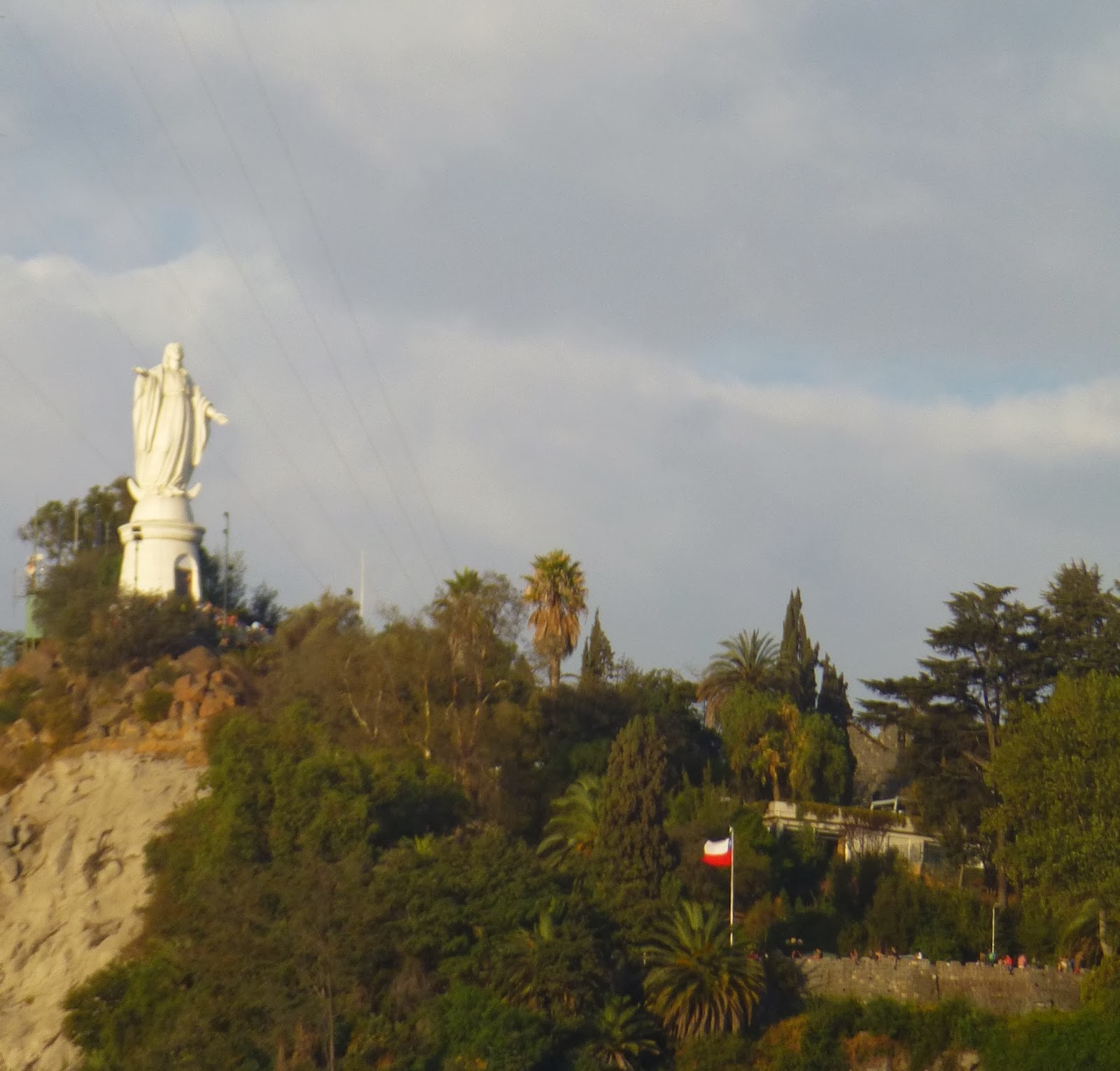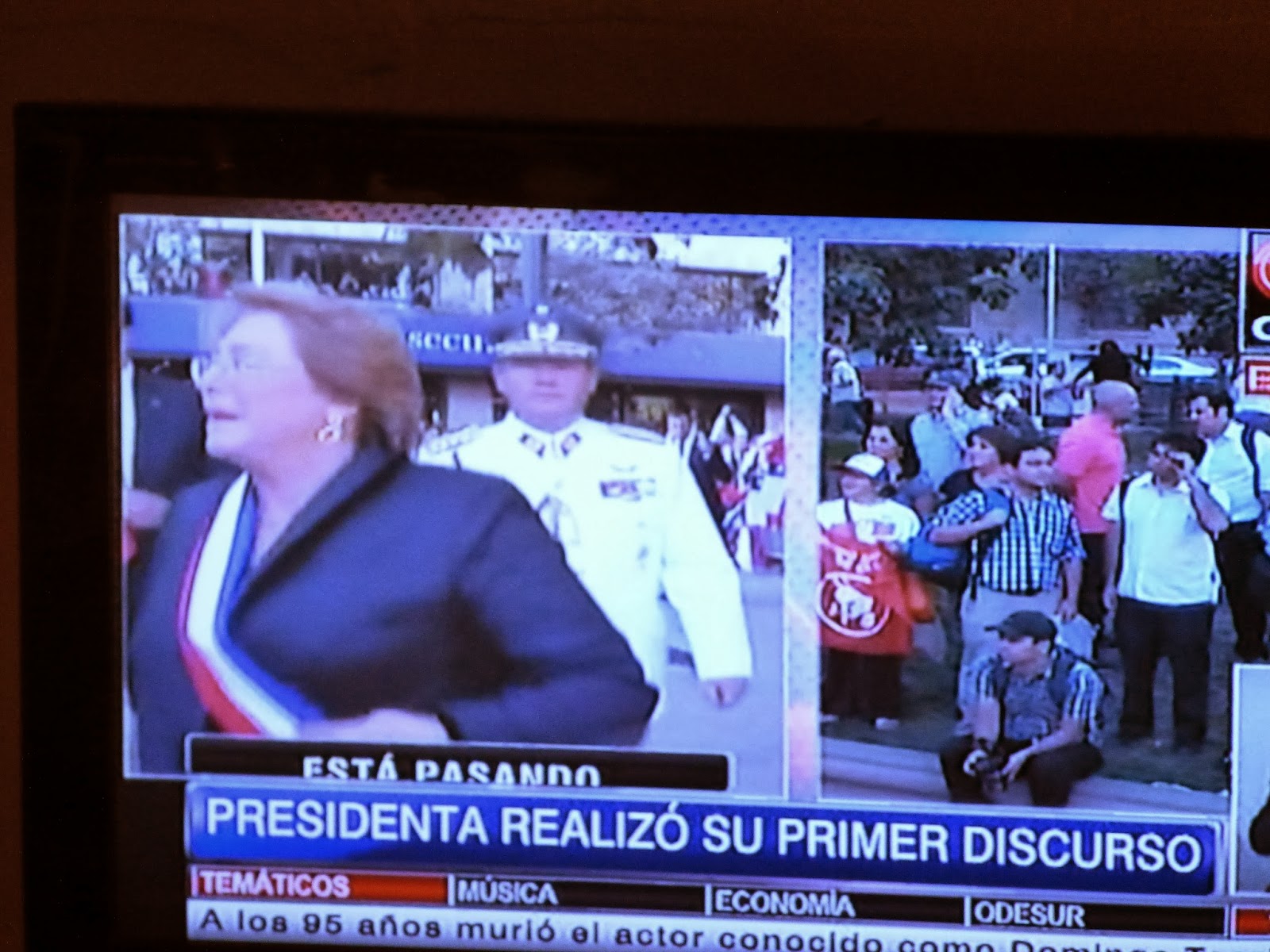Tuesday March 11 was inauguration day in Chile. President Michelle Bachelet (b. 1951) was sworn in as President for the second time. She was President from 2006-2010. After leaving the Presidency (one can only serve for four years at a time), she was the Executive Director of the UN Entity for Gender Equality and the Empowerment of woman. In December she was re-elected as President of Chile with 62% of the vote (she had 53.5 in the 2006 elections. Her father Alberto Bachelet was an Air Force Brigadier appointed by the Allende government in charge of the Food Distribution Office. Following the 1973 coup, he was imprisoned and following months of daily torture died following a cardiac arrest on March 12 1974. In January 1975, Bachelet and her mother were imprisoned and tortured and then exiled to Australia. She returned to Chile in 1979 to complete her medical studies.
We decided to visit the Museo de la Memoria y los Derechos Humanos (Museum of Memory and Human Rights), which President Bachelet opened in 2010.
First, the view of Cerro (Hill) San Cristobel from our apartment. There is a 14 m-hight statue of the Virgen de la Inmaculada Concepcion on the summit. It is Santiago's largest green space and the summit is accessible by funicular.
 |
| Cerro San Cristobal from our apartment |
 |
| Statue of the Virgin Mary at the summit |
 |
| Modern building downtown |
 |
| Dog on steps of building |
Barrio Brasil is characterized by vibrant street art and older crumbling housing. The following pictures are examples of the incredible street art in the Barrio-- very different than the street art we saw in Buenos Aires.
We also passed through Santiago's Chinatown- with a number of large Chinese restaurants.
We finally got to the Museum. The building itself is very powerful and beautiful and the exhibits very well presented to expose the human rights violations, torture, executions and disappearances that took place during the dictatorship between September 11, 1973 and March 1990.
Outside of Museum
The lower level, where we entered, and the only level where we were allowed to take photos, had plaques listing all the Truth and Reconciliation Commissions that have existed in some 30 countries over the years. Chile had two Commissions, one in 1990 and a later one in 2004, specifically dealing with the victims of torture. It has been estimated that at least 3500 people were killed by the junta, with at least 40,000 detained, of whom most were tortured. There were also thousands of people exiled, or not allowed to return to Chile during the dictatorship.
There was a stone map of Chile on the floor with markers for all the memorials that now exist to those detained, tortured and killed by the junta, as well as markers of many of the 1000 detention centres that were established across the country.
Stone map of Chile on the floor with markers showing memorials
One of the memorials in Santiago
Memorial for the disappeared and executed, in the General Cemetery in Santiago
There was also many artifacts of items made by detainees or prisoners. This school bag made by a prisoner for his daughter prior to his execution, was very moving.
We then went up the stairs to the first floor. There was an entire section dealing with the events of September 11, 1973, from 6:00 a.m. when Pinochet's troops captured Valparaiso, through the horrific bombing of La Moneda (Presidential Palace), to President Allende's last radio address, his suicide, the first detentions, and the first broadcasts of the junta at 6:00 p.m. There was a triptych of videos covering the events of the day, that was extremely powerful, especially the bombing of La Moneda. There were also stations with video recollections of witnesses, including former aides of Allende, of the events of September 11. Another section dealt with torture and detention, again featuring testimony of prisoners, many of whom were in their early 20s at the time. There was an iron bed with electro-shock equipment attached, as well as many crafts made by prisoners. There was a moving copper plaque made by Alberto Bachelet showing two hands clenching iron bars, just prior to his death.
Iron bed with electro-shock equipment (from Internet)
Copper plaque made by Alberto Bachelet (from Internet)
Wall of photos
The second floor dealt with events post-coup until the plebiscite in 1988, which lead to democratic elections in 1990. The exhibits dealt with student, union, religious and international opposition to the junta. There were also sections dealing with those forced into exile, or those individuals not allowed to return to Chile once they were out of the country. In 1986, there was an attempt to kill Pinochet, which resulted in the death of five of his bodyguards. This was followed by the retalliation kidnapping and killing of four leftists, whose bodies were left in the streets of Santiago. That same year, two young student demonstrators were burnt alive, with only one of them surviving.
There was also a section dealing with the misinformation campaigns of the junta and other dictatorships in South America to attribute disappearances to internal fighting of leftist groups. They were later found to be executions by the junta. There were also deliberate assassinations of opposition leaders living outside of Chile. The dictatorship was a brutal one. One gets a sense of the fear with which the Chileans lived during those years.
We left the Museum at 6:00 p.m. as it was closing. Luckily, we had almost finished seeing the permanent collection. We may return to see the temporary exhibit, as the English website and our guide book had said that the building did not close until 8:00 p.m. We took some pictures of the other side of the building as we were exiting. The Declaration of Human Rights is engraved on one wall of the building.
Declaration of Human Rights engraved on right wall
We passed some new beautiful street art and then stopped at a Cafe near the Plaza Brasil for a coffee and a snack.
Plaza Brasil
On one side of the Plaza Brasil was a building with pictures of Victor Jara (1932-1973), the Chilean songwriter and singer who was murdered by the junta in 1973. There is still a movement to bring his killers to justice.
Justice para Victor (Jara)
We stopped for coffee and a huge ham and cheese sandwich (lactose pills for me) at Cafe Cronica Digital, a leftist cafe with an innovative menu featuring drinks and dishes named after Chilean and other left politicians and events. The place was buzzing and there was a TV inside playing CNN Chile's coverage of the inauguration.
Cafe menu with reference to 1973-2013 anniversary of the coup
Creative menu with political references
Almuerzos del Pueblo de Chile- Chilean Peoples Lunches
Alano with the menu
CNN Chile coverage of the inauguration
In the course of peering inside to look at the CNN coverage, we realized that while the inauguration had taken place in Valparaiso, the President was back in Santiago and that celebrations must have been taking place at La Moneda. We hurried back to a scene of a few hundred stragglers and the clean up crew already in action. However, just as we arrived, we heard a bit of a buzz and saw Isabel Allende (Salvador Allende's daughter), newly appointed Leader of the Senate doing a walk about. This was thrilling, watching history being made. She had given President Bachelet the presidential sash at the Inauguration. Isabel Allende also just became the first woman to head the Senate, a position her father had also held for three years before he became President.
 |
| Lingering crowds in front of La Moneda-- flag in front of Presidential offices |
Poster near La Moneda- Chile for All, A Better Chile
We collected some souvenirs from the rally and walked back to the apartment at about 8:30 p.m. for a light dinner.
What a day!






























This was an excellent post Toby, juxtaposing the tumultuous recent history of Chile through the story of the Museum of Memory and Human Rights with the day of inauguration of President Michelle Bachelet, and then seeing and getting a photo of Isabel Allende as the new leader of the Senate was the icing on the cake. And in addition to the political story you interspersed great upbeat photos of street art and every day people, the inheritors of the political story told.
ReplyDelete